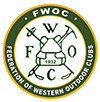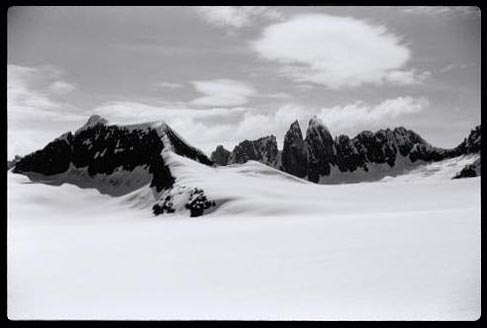
HISTORY of the FWOC
Home
About the FWOC
Join the FWOC
Member Organizations
Adopted Resolutions
Outdoors West (newsletter)
Officers
History

History: Agents and Members
The history of conservation in the American West is strongly linked to the history of the Federation of Western Outdoor Clubs (FWOC). From the early 1930s, it has provided support for conservation initiatives—support that has been regarded as crucial.
For the most part, what the federation has backed has become law, and what it has opposed has failed. Its agents and members helped secure passage of the Wilderness Act and made important contributions to the establishment of several national parks, wilderness areas, and national monuments.
History of the FWOC
Before the federation was founded in 1932, the support of some of its founding member clubs had been crucial on issues in their purview: the Mazamas (a nonprofit mountaineering education organization based in Portland), the Mountaineers (Seattle), and the Sierra Club (San Francisco). During this time, sporadic efforts were made to get their members together on climbs and summer camps.
In 1932, the Mazamas issued invitations to all the outdoor clubs on the West Coast to gather on Mt. Hood to form a permanent alliance: the Federation of Western Outdoor Clubs. Fourteen of them did, and the alliance has continued ever since, with a growing number of member organizations.
Representatives of these clubs have gathered each summer to hear speakers, exchange views, and pass resolutions to establish policies for the alliance. For decades, officials of federal conservation agencies attended the conferences, sometimes addressing the group. It had been common to see Forest Service officers in charge of wilderness areas attend. Officials of the National Park Service did as well.
Usually, member clubs take action on issues that are close to their base of operations. Leaders of the Mountaineers played a major role in the establishment of Olympic National Park. The Sierra Club was the prime mover in the establishment of Kings Canyon National Park. Leaders of the Mazamas led the way in getting Crater Lake National Park set aside, and the Trails Club of Oregon, led by Ding Cannon who was then the President of the Federation, got Forest Park set aside in Portland. It is the nation’s largest forested city park where the city tries to maintain wild conditions.
Later, the Sierra Club led the way in getting the Redwood National Park set aside, saving 20,000 acres of old redwoods with the federation’s support. The federation also supported the Sierra Club's successful campaigns to keep dams out of the Echo Park National Monument and the Grand Canyon. The federation also backed the efforts of its Nevada chapter in getting the Great Basin National Park set aside, and was staunch in supporting a coalition effort that succeeded in setting aside a host of new national parks and wildlife refuges in Alaska.
Over time, the composition of the organizations in the federation has evolved and changed, with more regional conservation groups joining, as well as many outdoor clubs, including some of its founding clubs. Now the number of participating groups has never been higher, representing well over a hundred thousand members.
When the campaign to pass the Wilderness Bill began, the first group in the west that the staff director for the Wilderness Society approached for support was the federation. Howard Zahniser spoke at the society's convention in the mid-1950s. The federation was an early backer of the bill and steadfast in its support. In fact, in the early 1960s its field organizer, Michael McCloskey, played a pivotal role in mobilizing enough support for the bill in a western Colorado district to get the bill passed by the House of Representatives where it had been blocked. Soon after, it became law.
For many years, the federation alternated with the Sierra Club in putting on wilderness conferences to generate support for passing the Wilderness Bill and later, for designating new areas as wilderness..
McCloskey tells a story of the significance of its meeting in 1958 on Hood Canal (WA). Most of the leaders of the national conservation movement came there to seek the federation’s support. It was McCloskey’s first conference. It allowed him to meet seminal figures in its history such as L.A. Nelson of the Mazamas who was at its initial gathering.
The federation’s impact expanded significantly when its leaders agreed to work with the Sierra Club to hire an organizer in the Northwest. Justice William O. Douglas, who came from Yakima, had been urging FWOC leaders to take this step. In the late 1950s, he pointed out that an organizer was the only way they could cope with the exploding number of issues. It needed a staff person who would travel the northwest like a circuit rider, carrying news, providing counsel, and doing research.
A Mountaineer leader, Leo Gallagher from Tacoma, agreed to donate half of the needed funding each year on behalf of the federation, while the Sierra Club agreed to provide the other half of the funding. Karl Onthank from the Eugene Obsidians agreed to recruit a person for the job as Northwest Conservation Representative. He recommended Michael McCloskey, a law student at the University of Oregon.
In the summer of 1961, McCloskey was hired. As it was set up, he represented not only the federation and the Sierra Club, but three other organizations as well: the North Cascades Conservation Council, the Oregon Cascades Conservation Council, and Olympic Park Associates. The arrangement continued for eleven years, from 1961-1972, until Gallagher died.
The Northwest Conservation Representative was the agent of the federation and its name was on most of the studies and proposals he put forth. McCloskey continued until 1965 when the Sierra Club alone hired him to come to San Francisco to assume a new job. Soon thereafter Brock Evans took over the job. Together they played major roles in moving many conservation programs forward on behalf of the federation.
McCloskey formulated a well-documented case for establishment of the North Cascades National Park, a report that energized the campaign and moved things off dead center. Later, Brock Evans was in the forefront of lobbying it through Congress.
McCloskey’s work also changed the course of other concerns of the federation. The Forest Service was thinking of dropping its Limited Area in Washington’s Alpine Lakes because of the presence of so many inholdings. This was even more the case with the huge Idaho Primitive Area. McCloskey showed how they were still viable. Then Brock Evans came up with proposals to expand them and mobilized support so that Congress weighed into protect the area in Idaho as well as that in Washington. Mccluskey’s proposals for an expanded Mt. Jefferson Wilderness bought time for a larger wilderness there that Brock Evans then pushed along.
McCloskey conceived of the High Mountain Policy that in 1962 kept most logging proposals out of the high country in the Cascades, saving Waldo Lake from the ravages of logging. He also got a road and logging kept out of the Minam Valley in Oregon’s Wallowas. This policy also helped save Washington’s Cougar Lakes Wilderness.
McCloskey helped pick up the pieces from the loss of 53,000 acres in the Three Sisters Wilderness. Brock Evans went on to organize a rejuvenated campaign to save the remnants. Twenty-one years after protection was removed, congress once again protected them.
McCloskey worked with the Wilderness Society to get wilderness protection for an expanded unit in Idaho’s Sawtooths. His proposal for a Sky Lakes Wilderness in Oregon guided the way toward its ultimate approval. He also weighed in for the federation to save the Cabinet Mountain Wilderness in Montana.
Evans provided the drive to change the fate of Hells Canyon. Instead of more dams being authorized there, he shifted the focus to obtaining a designation that would keep dams out of the canyon and protect its natural qualities.
All of these achievements occurred because of the federation. While many others played roles, the role of the federation and its agent were instrumental in the outcomes.
Through the years, the federation has been concerned with most of the leading issues in the west, has weighed in with resolutions on them and it has lobbied legislators in pursuit of passage.
As interest in conservation and then the environment grew through the 1960s, the number of its resolutions kept growing—from a dozen, to 20, to 30, and finally 50. At its 1970 conference in California at Idylwild, over a hundred people showed up, young as well as older folks, reflecting the enthusiasm of Earth Day.
In recent years, the federation and its officers have been deeply involved in the successful effort to establish a Giant Sequoia National Monument in the southern Sierra. Its one-time President, Joe Fontaine, did more than anyone to bring that about.
Over the years, the federation and its participants have been in the midst of the key conservation and environmental issues of the west and have played a role that shapes the quality of the environment in our region.
History: FWOC Convention Reports and Photos:
2017 Convention at Siskiyou Field Institute
Selma, Oregon
2016 Convention at IslandWood Educational Learning Center
Bainbridge Island, WA
2016 Convention Photo Gallery
2016 Convention Photo Collage 1
2015 Convention at Menucha on the Columbia River -
Photo Gallery Report
2010 Convention Report
Mt. Tamalpais - Mill Valley, California